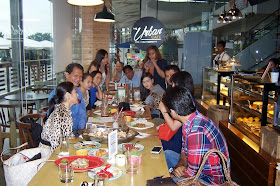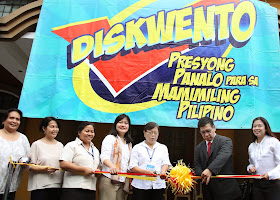
3RD
MINISTERIAL MEETING. Labor Ministers of the Abu
Dhabi Dialogue Member-States at their 3rd Ministerial Meeting in Kuwait pose
for a posterity photo at the conclusion of the meeting at the Sheraton
Kuwait. H. E. Hind Sobeeh Barak Al-Sabeeh, Minister of Labor and
Social Affairs of Kuwait, the incoming ADD Chairman, (7th from left) is flanked
by Philippine Labor and Employment Secretary Rosalinda Dimapilis-Baldoz,
representing the Philippines as the outgoing ADD Chairman. On Baldoz's left is
H.E. Qatar Labor
Minister H.E. Abdullah Saleh Al-Khulaifi with whom Secretary Baldoz had a
bilateral meeting in Doha, Qatar last Sunday.

PH DELEGATION AT 3rd ADD MINISTERIAL MEETING. Philippine
Labor and Employment Secretary Rosalinda Dimapilis-Baldoz (6th from left) joins
the members of the Philippine Delegation to the 3rd Ministerial Meeting of the
Abu Dhabi Dialogue of which the Philippines is the outgoing Chairman. The
delegation is composed of (L-R) Dir. Saul de Vries of the International Labor
Affairs Bureau; Assistant Labor Attache to Kuwait Lily Pearl Guerrero; Labor
Attache to Abu Dhabi Atty. Ofelia Almenario; Overseas Workers Welfare
Administration Chief Rebecca Calzado; Undersecretary for Social Protection and
POLOs in the Middle East in-charge Ciriaco Lagunzad III; Sec. Baldoz;
Philippine Overseas Employment Administration Chief Hans Leo J. Cacdac; Labor
Attache to Qatar Leopoldo de Jesus; Labor Attache to Kuwait Cesar Chavez; Labor
Communications Director Nicon F. Fameronag; and Technical Education and Skills
Development Authority Deputy Director General Irene Isaac.
(Photo by Judith
Mag-uyon).
________________________________________
Abu Dhabi Adopts Philippines Comprehensive Information and Orientation Program for Migrant Workers
Labor and Employment Secretary Rosalinda Dimapilis-Baldoz recently lauded the success of the 3rd Ministerial Meeting of the Abu Dhabi Dialogue (ADD), hosted by and held in Kuwait, citing the ADD’s adoption of the Philippines’s proposal to implement a Comprehensive Information and Orientation Program for Migrant Workers, a joint undertaking of ADD member-states aimed at fostering professional relationships between migrant workers and their foreign employers, as well as intermediaries.
Officially known as the Ministerial Consultations on Overseas Employment and Contractual Labour for Countries of Origin and Destination in Asia, the ADD was established in 2008 and groups together eleven Colombo Process countries of migrant worker origin, namely, Afghanistan, Bangladesh, China, India, Indonesia, Nepal, Pakistan, Philippines, Sri Lanka, Thailand, Vietnam; and nine Asian destination countries, namely, Bahrain, Kuwait, Malaysia, Oman, Qatar, Saudi Arabia, Singapore, United Arab Emirates, and Yemen.
Labor Sec. Rosalinda D. Baldoz
“The Philippines is now prepared to shepherd the implementation of the Comprehensive Information and Orientation Program for Migrant Workers,” said Secretary Baldoz in a statement after the ADD Ministers adopted the Philippine proposal, together with two others.
“The overwhelming support of senior officials of ADD member-states to this project encourages us to accelerate the preparatory work toward the development of the various orientation and education modules of the project,” she added.
The other day, senior officials of ADD member-states overwhelmingly voted, after extensive discussions, to recommend the project for adoption in the Ministerial Meeting.
The Philippine proposal seeks to facilitate workers’ adaptation to their employment overseas and familiarize them with their rights and responsibilities, as well as with grievance mechanisms in their country of destination.
“The project’s objective is to prepare migrant workers for overseas employment through education and timely information for better adaptation. It seeks to ease adjustment difficulties of temporary migrant workers,” Baldoz explained.
The CIOP, which is for two years, involves a joint education module for each of the four stages of migration—before departure, upon departure, upon arrival, and upon return—to prepare migrant workers. It involves the development of a framework for the implementation of a Pre-Employment Orientation Session (PAOS); Pre-Departure Orientation Session (PDOS); Post-Arrival Orientation Session (PAOS); and Reintegration Counseling. It also involves capacity-building for trainors and program managers.
“Once they arrive in their COD, the government and employers of the receiving country shall use the education module to integrate them much faster, not just in the workplace, but also in the society of the receiving country. This will minimize problems attendant to migration,” Baldoz said.
She acknowledged that most, if not all, ADD labor-sending member-states have already institutionalized Pre-Departure Orientation Sessions, or PDOS, for departing migrants, but she said these still can be improved, citing the Philippines’s Comprehensive Pre-Departure Education Program that includes language training, culture familiarization, and stress management.
She also cited the Philippine Overseas Employment Administration’s Pre-Departure Orientation Seminar, or PEOS, which is now online.
She said the project will enable labor-sending and labor-receiving countries to share responsibility in responding to the critical need for relevant orientation and education of migrant workers at the point of decision to work overseas, at the workplace, and upon their return to their home countries.
“All stakeholders must be committed, both in COO and COD, to minimize problems in the entire cycle of migration, and maximize the opportunities offered by international labor migration,” said Baldoz.
She added that the Philippines, as lead of the project management team, is set to meet with other team members, namely, Bangladesh, Kingdom of Saudi Arabia, United Arab Emirates, Bahrain, Vietnam, and Thailand, in the first quarter of 2015 to begin work on the development of the program management framework and the PEOS, PDOS, PAOS, and reintegration counseling modules. (TedyChoBlogs)





















.JPG)



